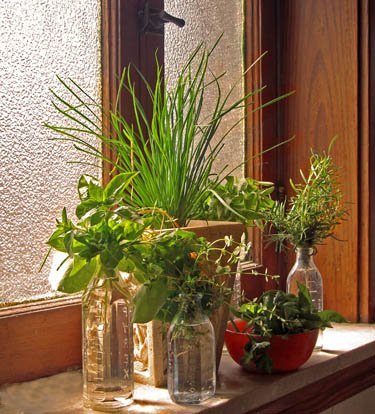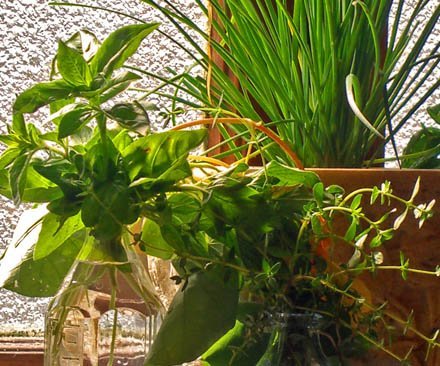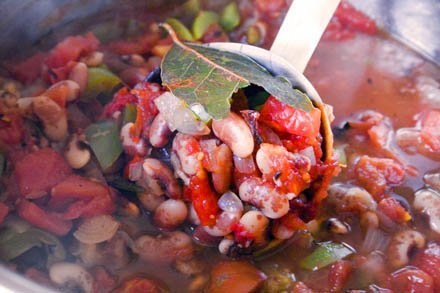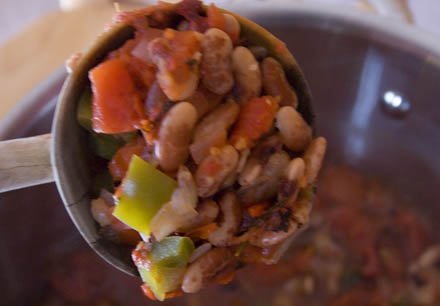
The garden has arrived at that happy state where the plants are growing faster than the bugs can eat them. Please don’t let this be a jinx when I say that things are looking like we’re headed for a bumper crop.
The beans are robust and reaching unflinchingly toward their teepee supports. The tomatoes are vigorous — Dad’s Sunset and Mexico Midgets, which were put in the ground first, sport delicate flowers. The peppers are inching along, the Hungarian Black, Sheepnose pimento, Mini red bells and the chocolate jalapeno, but they’re always slow. The only undecided plant is the white eggplant – it has just three leaves and seems nonplussed by all the activity surrounding it.
And the herbs! Those are busting out all over. Dill has opened its umbrella seed heads, and the basil had to be snipped back to keep it from flowering. Cilantro too is bolting, and the parsley is lush and bright and nearly wild. The nasturtiums are sprawling over the edges of their pots, and thyme is crawling along the underbrush, filling in all the spaces. Oregano and marjoram are the size of woodchucks, which have, blessedly, left them alone.
Is it wrong, do you think, to lop off the tops of herbs just before they put on their seeds? I suppose in some way it probably is. Wandering the rows and shaving back the bushy greens, I couldn’t help feeling, as I often do, that I’m somehow cheating the plants of their purpose. From the moment they cracked open their own shells and spread their first false leaves, they were on a trajectory to producing seeds that could produce seeds that could produce…. How I feel then is not unlike what I feel when I inevitably turn up half a worm with my garden spade. My consolation? These plants will soon outrun me. If they’re growing faster than the aphids can eat them now, by months end they’ll be getting vertical faster than I can dream up a new take on pesto.
This herbaceous abundance will surely shape the culinary concoctions that greet here over the next many delicious months. Today’s post is a celebration of this treasure trove.
I was aiming for something that would let each flavor stand out against the other ingredients. I also have to admit that I was aiming for an easy recipe with minimal ingredients, something cool and quick and fully within the capacity of a one-legged woman to whip up.

Yes. I tripped over a goat/fell off a boat/slipped on some beans/lost the blindfolded relay (which is your guess?). That one-legged woman is me. And so, I’ll be gimping along for the next several weeks, my leg in a cast and my hands full of crutches. How long is not known – and here I’ll ask you to please send healing thoughts and wishes my way. I’m a great believer in the power of our energy and intentions to shape the world, and I’ll take all the help I can get. These crutches are making me crabby!
What this means for you, dear reader, is minimalist recipes.
The recipe(s):
You may remember, from my Frito Burrito post, that I have a weak spot for the salty snack. Turns out, lima beans go well with Scoops!
You also may recall that I am loathe to stick heirloom beans in a food processor. Push the red button and at once they’ve lost their identifying shapes and traits. I don’t feel as bad when I’m using a plain looking bean, and today I used two plain beans, one heirloom, one not.
The heirloom is the Gigandes, a large, flat, creamy green Lima from Purcell Mountain Farms. Like so many heirlooms, it has many aliases, and is sometimes referred to as a butter bean, a curry bean, Madagascar bean, lab bean, and cape pea. Flavor-wise, this bean is both acidic and creamy.
This bean has racked up some frequent flier miles. Native to Central America, it made its first stop in Peru. Spanish explorers took it along to Europe, where it was suited to the temperate climate. Later the slave trade carried it to Africa, where it continues to be an important part of the diet and culture.
I thought the greenness of the bean would work well with the sharp greenness of the herbs, but my taste buds said otherwise. It worked better if the “green” flavor was cut in half with another kind of bean. So… I got out the can opener. No, not a can of heirlooms. I used cannelini beans, because they have a rich, creamy texture – perfect!
It was hard to know where to start with the herbs, and so I ended up making three batches of herby bean dip, each featuring a combination of fresh green leaves and a mixture of the two beans. I also wanted to experiment with texture, and used yogurt and goat cheese.
These dips are all fantastic on Frito Scoops, of course. But they’d be just as nice on toasted bread, whole wheat pitas, crackers, veggies. My favorite use so far? As a sandwich spread. So get crazy!

Two Beans Three Ways: Herbed Bean Dip
8 ounces (about 1 cup) cooked Gigandes, or other lima beans
8 ounces cooked cannellini beans
3 cloves garlic, minced
Zest of one lemon
Juice of one lemon
4 ounces of plain yogurt, or 4 ounces goat cheese (optional)
1/3 cup fresh Italian flat-leaf parsley
1 teaspoons salt, or to flavor
1/2 teaspoon freshly ground pepper
Olive oil if needed
Fresh garden herbs:
2 tablespoons chopped thyme or lemon thyme
4 large nasturtium leaves plus 1 or 2 of the flowers
– or -
1/3 cup fresh basil
– or -
1/3 cup fresh oregano leaves
1 tablespoon fresh marjoram
(Note: my favorite combination was the fresh basil, with the goat cheese)
Place the limas and the cannelinis in a food processor, along with the garlic, lemon zest, lemon juice, yogurt or goat cheese if using, parsley, salt and pepper. Puree until smooth and creamy, adding a bit of olive oil if necessary to achieve a smooth texture.
Add the fresh herbs and puree again until herbs are minced and worked into bean spread.
Adjust salt and pepper as necessary, and serve! Easy peasy.



